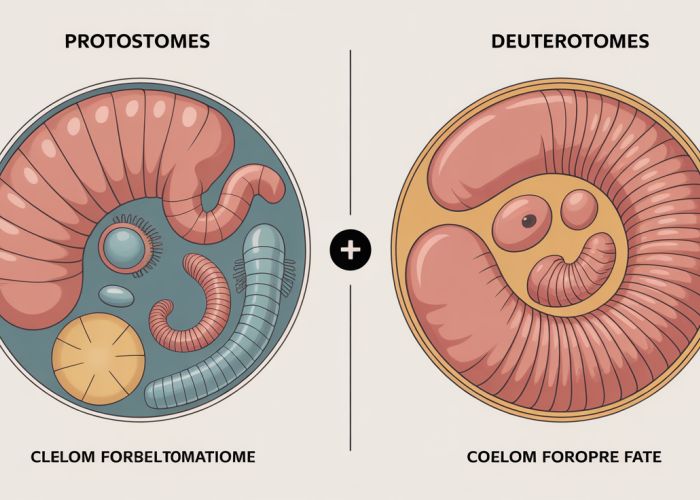Embryonic development, a foundational concept in zoology, fundamentally differentiates protostomes vs deuterostomes animals. The blastopore, a crucial structure during gastrulation, exhibits contrasting fates in these two major animal lineages. Specifically, in protostomes, the blastopore develops into the mouth, an observation first extensively documented by Karl Grobben. This starkly contrasts with deuterostomes, where the blastopore gives rise to the anus, highlighting a key divergence in the evolutionary paths of protostomes vs deuterostomes animals. Understanding these processes is important when studying marine ecology.

Protostomes vs Deuterostomes: Key Differences Explained!
Understanding the animal kingdom involves recognizing fundamental divisions in embryonic development. Two major groups, protostomes and deuterostomes, are distinguished by several key developmental differences, particularly concerning the fate of the blastopore. These differences have significant implications for the overall body plan and evolution of these animal groups. This article clarifies these "protostomes vs deuterostomes animals".
Cleavage Patterns: Spiral vs. Radial
One of the earliest distinguishing features between protostomes and deuterostomes lies in their cleavage patterns during embryonic development. Cleavage refers to the rapid cell division that occurs immediately after fertilization.
Protostome Cleavage: Spiral and Determinate
- Spiral Cleavage: In protostomes, the cells divide in a spiral pattern relative to each other. This means that new cells sit in the grooves between older cells, resulting in a spiraling arrangement.
- Determinate Cleavage: Protostome cleavage is also determinate (or mosaic). This implies that the fate of each cell is determined very early in development. If a cell is separated from the embryo at an early stage, it cannot develop into a complete organism because its developmental potential is already restricted.
Deuterostome Cleavage: Radial and Indeterminate
- Radial Cleavage: Deuterostomes exhibit radial cleavage, where cell divisions occur parallel or perpendicular to the animal-vegetal axis. This results in cells arranged directly above or below each other, creating a radial symmetry in early development.
- Indeterminate Cleavage: Deuterostome cleavage is indeterminate (or regulative). This means that the fate of each cell is not determined until later in development. If a cell is separated from the embryo at an early stage, it can still develop into a complete organism, as demonstrated by the formation of identical twins.
Blastopore Fate: Mouth vs. Anus
Perhaps the most well-known difference between protostomes and deuterostomes concerns the fate of the blastopore. The blastopore is the opening that forms during gastrulation, the process by which the three primary germ layers (ectoderm, mesoderm, and endoderm) are established.
Protostomes: "Mouth First"
- In protostomes, the blastopore typically develops into the mouth. The anus, if present, forms later from a secondary opening. The name "protostome" literally means "mouth first."
- Examples of animals exhibiting this pattern include arthropods (insects, crustaceans), mollusks (snails, clams), and annelids (segmented worms).
Deuterostomes: "Mouth Second"
- In deuterostomes, the blastopore develops into the anus. The mouth forms later from a secondary opening. The name "deuterostome" means "mouth second."
- Examples of animals exhibiting this pattern include echinoderms (sea stars, sea urchins) and chordates (vertebrates, including humans).
Coelom Formation: Schizocoelous vs. Enterocoelous
The coelom is a fluid-filled body cavity located between the body wall and the digestive tract. It provides space for organ development and can act as a hydrostatic skeleton in some animals. The way the coelom forms differs between protostomes and deuterostomes.
Protostomes: Schizocoelous Formation
- In schizocoelous coelom formation, the coelom develops within the mesoderm. The mesoderm splits, forming a cavity that becomes the coelom. "Schizo" means "split," referring to the splitting of the mesoderm.
Deuterostomes: Enterocoelous Formation
- In enterocoelous coelom formation, the coelom develops from outpocketings of the archenteron (the primitive gut). These outpocketings pinch off and form the coelomic cavities. "Entero" refers to the gut, indicating the origin of the coelom.
Summary Table
| Feature | Protostomes | Deuterostomes |
|---|---|---|
| Cleavage | Spiral and determinate | Radial and indeterminate |
| Blastopore Fate | Mouth | Anus |
| Coelom Formation | Schizocoelous (splitting of mesoderm) | Enterocoelous (outpocketing of gut) |
| Examples | Arthropods, Mollusks, Annelids | Echinoderms, Chordates |
FAQs: Protostomes vs Deuterostomes
Here are some frequently asked questions about the key differences between protostomes and deuterostomes.
What’s the easiest way to remember the protostome/deuterostome difference?
Think about the blastopore. In protostomes, the blastopore develops into the mouth first. In deuterostomes, the blastopore develops into the anus first, hence "deuter" meaning second, implying the mouth forms second. This is a fundamental difference among protostomes vs deuterostomes animals.
Does this difference affect how the animal develops beyond the mouth/anus formation?
Yes, significantly. The early cell cleavage patterns differ, with protostomes exhibiting spiral cleavage and deuterostomes exhibiting radial cleavage. This impacts the developmental potential of cells. Also, the coelom formation is different – schizocoelous in protostomes and enterocoelous in deuterostomes.
Are humans protostomes or deuterostomes animals?
Humans are deuterostomes. Along with other chordates and echinoderms, we share the characteristic of the blastopore forming the anus first during embryonic development.
What are some examples of protostomes vs deuterostomes animals?
Common examples of protostomes include mollusks (like snails and clams), annelids (segmented worms), and arthropods (insects, spiders, crustaceans). Examples of deuterostomes include echinoderms (starfish, sea urchins) and chordates (vertebrates like fish, amphibians, reptiles, birds, and mammals, including humans).
So, there you have it – a quick rundown of protostomes vs deuterostomes animals! Hopefully, you’ve now got a clearer picture of what sets these two groups apart. Happy learning, and maybe you’ll even impress your friends with your newfound knowledge!



